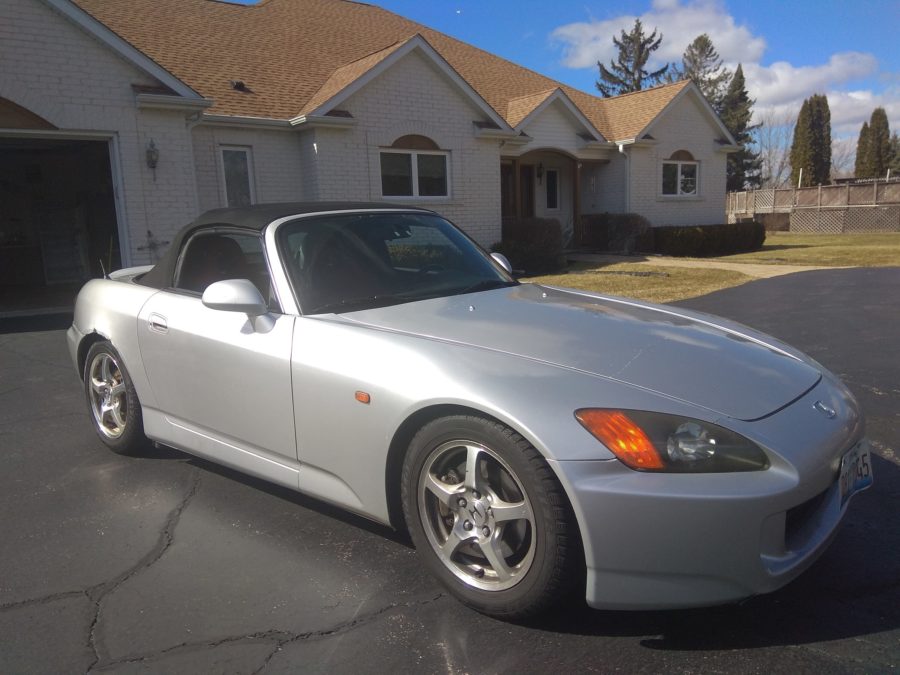Drifting is, inherently, a quite expensive sport. Between tires, fuel, repairs, and event fees, the money keeps flowing out the longer you drift. Thinking logically, you’d assume that the car is the most expensive up-front cost, right? Bingo! Now, how can we lower this cost, and get you a better drifting experience? By choosing the right car! For those of you in a rush, here is a list of 11 drift cars you can get for cheap, ordered by average price:
- Mazda Miata
- BMW 3-series E36
- Mazda RX-8
- Ford Mustang
- Nissan 350Z
- Nissan 240SX S13
- Lexus IS300
- Nissan 240SX S14
- BMW M3 E36
- Honda S2000
- Mazda RX-7
For those of you looking for more info about each of these cars, don’t fret, keep scrolling!
1) Mazda Miata ($1,000-$3,000)
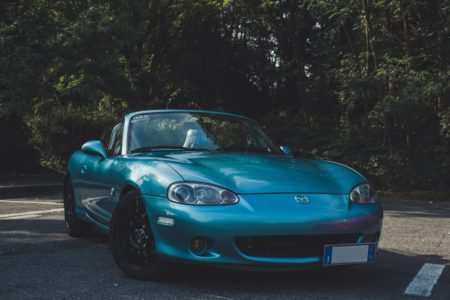 Now, it’s commonplace to say that “Miata is always the answer”. While it has become a meme by this point, it’s true in this case! A used Mazda Miata is one of the best ways to get into a drift car for cheap. While there were many different generations, and even more trim levels and engines, I suggest looking for one with the 1.8L engine. While the 1.6L is a little lighter, and has much better turbocharging potentials, we’re looking for cheap ways to get into drifting. Slapping a big-ol hair dryer to your engine isn’t usually cheap, and if it is, it sure won’t be reliable.
Now, it’s commonplace to say that “Miata is always the answer”. While it has become a meme by this point, it’s true in this case! A used Mazda Miata is one of the best ways to get into a drift car for cheap. While there were many different generations, and even more trim levels and engines, I suggest looking for one with the 1.8L engine. While the 1.6L is a little lighter, and has much better turbocharging potentials, we’re looking for cheap ways to get into drifting. Slapping a big-ol hair dryer to your engine isn’t usually cheap, and if it is, it sure won’t be reliable.
There were quite a few transmissions as well. The easiest and safest route is the 6-speed manual. Drifting with an automatic is much more difficult, and the 5-speeds tend to be less reliable than their 6-speed brothers. Really, the only thing you need to do to begin drifting is weld the differential. This is true with a few cars on this list, they were produced from factory ready-to-drift. The engines aren’t that powerful, but the cars are light. With a well-timed flick or a clutch kick, you’ll be sideways in no time.
Cons
While the Miata is incredibly cheap, pretty reliable, and very light, it’s also short. With such a small wheelbase, this car is incredibly prone to snap oversteer. Also, when trying to drift at higher speeds, this car takes full commitment to keep sideways. You can get it sideways, however, you don’t have the power to keep it sideways. If you take advantage of clutch-kicks, though, you should be able to keep the drift going. The biggest issue with the Miata, though, is the rust. It’s quite rare to find any early Miasmas that don’t have rust covering them. The Miata was made to be a light-weight car, so they skimped on some of the under-body sealants. They must’ve been geniuses, because when the body rusts away, the car will be even lighter!
2) BMW 3-Series E36 ($1,500-$4,000)
 This car truly epitomizes the “factory ready-to-drift” idea. If you get one with a straight-6 engine and a manual transmission, you can just weld the differential, and you’ve got a drift car! These cars are only a little more expensive than the Miata, but a lot heavier. If you choose to gut the interior, you might be able to get some of your money back in resale. These engines are a little more powerful than those in the Miatas, making getting sideways easier. However, the real gem of these engines is that they’re practically bulletproof. These engines were made extremely well, and can take the abuse that drifting puts on them.
This car truly epitomizes the “factory ready-to-drift” idea. If you get one with a straight-6 engine and a manual transmission, you can just weld the differential, and you’ve got a drift car! These cars are only a little more expensive than the Miata, but a lot heavier. If you choose to gut the interior, you might be able to get some of your money back in resale. These engines are a little more powerful than those in the Miatas, making getting sideways easier. However, the real gem of these engines is that they’re practically bulletproof. These engines were made extremely well, and can take the abuse that drifting puts on them.
These cars are also incredibly cheap for what you get. BMWs have a lot of creature comforts, including Power seats, heat, and.. heated seats.. This wasn’t a joke, I swear! However, these comforts really do matter, as that makes them much more valuable to sell. That, or that could make this car a good daily driver. If you leave the comforts in, you won’t notice the discomforts as much, making it tolerable to drive consistently. However, if you wanted to put a bucket seat in, that wouldn’t be an issue, selling the stock seat would get you most of the money back.
Cons
While this is an incredibly cheap and easy way to get drifting, finding one that has been well-serviced can be difficult. Making sure the car has been taken care of is crucial, as that will cut down on your repair costs. While parts are plentiful, you’ll be getting them second-hand, as OEM parts cost an arm and a leg. The biggest con about this, though, is that BMWs are heavy. It’ll take a lot of labor to gut the interior enough to make this a light-ish car. If you drift it the way it is, you should have enough power to slide, but you’ll have a lot of momentum, making it harder to stop or turn.
3) Mazda RX-8 ($1,800-$4,500)
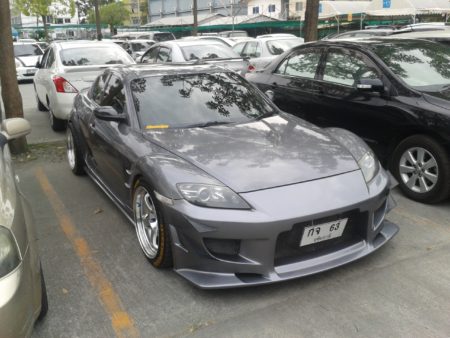 This is easily the highest maintenance car on this list, however, one of the coolest also. These cars have Wankel Rotary engines in them, a completely different design than your standard piston engine. They have very few moving parts, allowing for extreme rotation speed. That is at the cost of low fuel efficiency and torque, however. These cars have an incredible, almost perfect weight distribution for drifting, primarily because the engine itself is incredibly small. There’s also a full interior, with back seats as well, in case you need to bring other people (ew no) or spare parts (that’s more like it) with.
This is easily the highest maintenance car on this list, however, one of the coolest also. These cars have Wankel Rotary engines in them, a completely different design than your standard piston engine. They have very few moving parts, allowing for extreme rotation speed. That is at the cost of low fuel efficiency and torque, however. These cars have an incredible, almost perfect weight distribution for drifting, primarily because the engine itself is incredibly small. There’s also a full interior, with back seats as well, in case you need to bring other people (ew no) or spare parts (that’s more like it) with.
With such a quirky engine, these cars have difficulty starting drifts, but can maintain them well. Due to low torque, initiating a drift needs to be done with a hard clutch-kick or grabbing the handbrake. However, once you’ve got the engine spooled up, you’ve got the power to keep the wheels going through a couple gears. Did I mention.. FLAMES!? The rotary engine’s valve-less design allows for fuel to escape into the exhaust quite frequently, making a nice fireball out the tail.
Cons
“With decent power and no torque comes massive repair bills” my Uncle Ben used to tell me.. I think that’s what he said at least. These engines are extremely prone to sucking oil like soda, overheating, and just plain blowing up. The design of the engine attempts to lubricate the apex seals by dousing them in oil (apex seals are on the edges of the rotors, and take up the space between the housing and the rotor edge). A lot of this oil doesn’t make it to the seal, or gets burned up while it’s on the seal, leading to high oil consumption. Not only that, but these engines can run hot. With such high RPMs, there’s a lot of combustion going on, all that creating heat, and reducing the effectiveness of those booms.
The biggest problem, by far, is the apex seals. Anybody who owns a rotary, or has in the past, will tell you to avoid any car that “just needs apex seals”. To replace apex seals, you need to: Pull the motor, tear it apart, remove both rotors, replace the seals (keeping everything sterile the whole time), then reassemble the motor, drop it back in the car, and pray you don’t find any “extra parts” lying around. That’s a lot of time and stress if you do it, and a lot of money if you have a shop do it. Even just replacing the motor is a hassle!
4) Ford Mustang ($2,000-$5,000)
 Now, I’ve made plenty of jokes about these cars. Here will be no exception! If you love crowds so much that you want to share your car with them, the Mustang is for you! With many different years, and quite a few engines to choose from, there’s a Mustang out there for you! I’ll always recommend the V8 if possible, but most of the V6s have enough “oomph” to keep you sideways. Speaking of sideways, what’s the best way to introduce your new car to the community? Dang, I spoiled the joke! The displacements of these V8s, for the sake of drifting, don’t much matter, as long as you’re 1990 and newer. Repairs are fairly cheap too, with so many of these cars being built, there’s extra parts out the wazoo!
Now, I’ve made plenty of jokes about these cars. Here will be no exception! If you love crowds so much that you want to share your car with them, the Mustang is for you! With many different years, and quite a few engines to choose from, there’s a Mustang out there for you! I’ll always recommend the V8 if possible, but most of the V6s have enough “oomph” to keep you sideways. Speaking of sideways, what’s the best way to introduce your new car to the community? Dang, I spoiled the joke! The displacements of these V8s, for the sake of drifting, don’t much matter, as long as you’re 1990 and newer. Repairs are fairly cheap too, with so many of these cars being built, there’s extra parts out the wazoo!
With the Mustang, the trim names differ between the years. The GT trim is always a V8, between 4.6L and 5.1L. Usually they’re also equipped with a “5.0” badge on the side, regardless of actual displacement. The gearboxes are fairly strong, and can handle the horsepower you’re putting down. With some minor tweaks to the engine, you can easily be dropping mid 300s in power. Stock, you can look at around 6 seconds to 60, the quarter in mid 14s, and across the street before you know it. Why’d the Mustang cross the road? Because it saw a crowd over there!
Cons
Stereotypes. While Mustangs are kind of old, they’re still a hit with crowds! On a more serious note, Mustangs are a lot of power, for not a lot of money. If you’re driving on the road, and you lose control, you lose control. It’s incredibly difficult to get back under control. Rust is another issue with this car, as the Mustang was meant to be cheap and fast. Cheap means not the best build quality, so expect some rust, and expect some repair bills too.
5) Nissan 350Z ($4,000-$6,000)
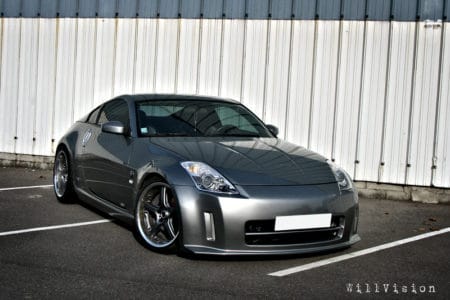 While other cars are known as track cars that can drift, this is more commonly known as a drift car that can go to the track. Mostly made famous from Fast and Furious: Tokyo Drift, the 350Z has plenty of power, an LSD with most trims, and a solid 6-speed manual, these cars can be (quite literally) drifted off the showroom floor.. Though I wouldn’t recommend that. The 350Z had very few updates through it’s years, with a slightly revised motor and a small facelift in 2006, giving just a little bit more horsepower, but that’s about it. When buying a 350z, that shouldn’t be your primary concern.
While other cars are known as track cars that can drift, this is more commonly known as a drift car that can go to the track. Mostly made famous from Fast and Furious: Tokyo Drift, the 350Z has plenty of power, an LSD with most trims, and a solid 6-speed manual, these cars can be (quite literally) drifted off the showroom floor.. Though I wouldn’t recommend that. The 350Z had very few updates through it’s years, with a slightly revised motor and a small facelift in 2006, giving just a little bit more horsepower, but that’s about it. When buying a 350z, that shouldn’t be your primary concern.
The 350z, wherever you go, will be recognized as a drift car. You’ll probably have people even ask you whether you drift your car, depending on the area. This is a perfectly capable daily driver, though. With comfortable seats, heat and AC, and plenty of storage space, you can take this car to grab groceries without a fuss. Though arguably the best feature of the 350z is that it’s so drift-ready from factory, that you’ll have to put hardly any money into the car.
Cons
There are only two cons to a 350z, honestly. First off, with this being a cheap sports car, people will have beat on it. Odds are, those people weren’t very skilled, either. Somebody may have crashed or damaged the car trying to drift it. That could lead to unforeseen repair bills, or even damaged parts failing while you’re driving. Be careful to inspect the car thoroughly before buying. Secondly, the noise. Some people really like the sound a 350Z makes, saying it sounds like an exotic. Others.. don’t, and refer to it as the “Butt Trumpet”. Before you commit to buying one of these cars, be sure that you like the noise, because drifting, you’ll be hearing a lot of it.
6) Nissan 240SX S13 ($4,000-$10k+)
 That’s quite the intimidating price range, isn’t it? With models ranging well into the tens of thousands of dollars, how did it get so expensive? Two words, my friend: Drift Tax. Since the S13 hasn’t been made since 1994, there are less and less of them every year. Despite starting out with roughly 200,000 S13s made, these cars were common to drift, and eventually, crash. The few S13s that are left (and even fewer stock ones) can fetch an incredible amount of money. However, as with any car, there are deals around. I got my S13 for the low end, I paid about $3500, and drove it six hours home.
That’s quite the intimidating price range, isn’t it? With models ranging well into the tens of thousands of dollars, how did it get so expensive? Two words, my friend: Drift Tax. Since the S13 hasn’t been made since 1994, there are less and less of them every year. Despite starting out with roughly 200,000 S13s made, these cars were common to drift, and eventually, crash. The few S13s that are left (and even fewer stock ones) can fetch an incredible amount of money. However, as with any car, there are deals around. I got my S13 for the low end, I paid about $3500, and drove it six hours home.
There’s a reason these cars are so expensive, though. These cars make for excellent drift cars, with almost perfect weight distribution, light curb weight, simple mechanics, and an engine bay that can support a variety of engines. No doubt you’ve seen people cram massive engines into tiny cars, like the Hellcat-powered Miata. With the S13, though, there’s enough room that you won’t need to custom fab driveshafts and motor mounts, or cut holes in the hood (style points for doing it though). If you lower the mounts just a hair, you can fit engines like the LS3 or VQ35DE in there for a more reliable, stable powerband. If you’re looking for wild, you could always go the SR20DET route, those are capable of pushing close to 500 with bolt-ons, or just turbo the aforementioned LS3.
Cons
Now, buying one of these cars is no easy feat. With such an old car comes lots of wear and tear, and especially rust. These can eat a car’s structural integrity away, leaving you driving a cardboard box. Not only is this dangerous in a crash, where you’ll have no effective crumple zones, but the car could just fall apart if you hit a pothole. These are also incredibly expensive if you aren’t patient. Most people know of the drift tax, and how much they stand to make off selling their car. Finding the ones who don’t is a struggle.
7) Lexus IS300 ($4,500-$8,000)
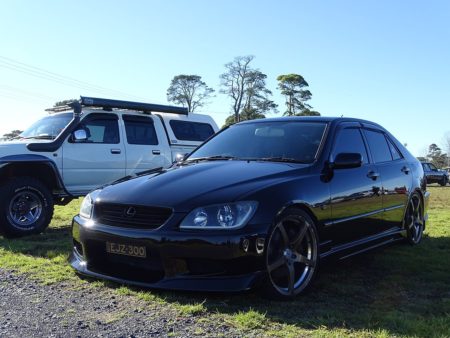 While the Lexus brand is usually associated more with style and comfort than performance, there are notable exceptions. The most famous of these is the LFA, a 550whp supercar with the best sounding V10 known to man. However, that’s not the car we’re talking about, as $400,000 isn’t exactly “cheap”. We’re here to talk about one of the lower models, the IS300. Powered by the infamous 2JZ, this car is quite literally a Supra-sedan. While this is an NA model of the 2JZ, it still has incredible tuning potential. These cars make for incredible sleepers, as they don’t look any different than grandma’s old Lexus, but there’s well over 1000 hp potential under the hood.
While the Lexus brand is usually associated more with style and comfort than performance, there are notable exceptions. The most famous of these is the LFA, a 550whp supercar with the best sounding V10 known to man. However, that’s not the car we’re talking about, as $400,000 isn’t exactly “cheap”. We’re here to talk about one of the lower models, the IS300. Powered by the infamous 2JZ, this car is quite literally a Supra-sedan. While this is an NA model of the 2JZ, it still has incredible tuning potential. These cars make for incredible sleepers, as they don’t look any different than grandma’s old Lexus, but there’s well over 1000 hp potential under the hood.
Finding one of these that hasn’t been modified shouldn’t be too hard, but finding one in manual is more difficult than you’d imagine. If you don’t mind working on it a bit to convert it to manual. As an automatic, they don’t have much drifting potential, and the transmissions that came in them definitely can’t handle the power a 2JZ can put down.
Cons
Like I said, finding one with a manual is difficult, and finding one that’s unmodified is even more rare. If you’re looking to get a ton of attention while you’re driving, this probably isn’t the car for you. However, if you get nice coilovers or put it on bags, get some camber, and a nice set of wheels, you could join the stance nation still.
8) Nissan 240SX S14 ($4,500-$10k+)
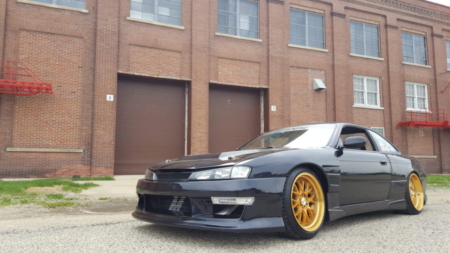 Another 240, another $10k+! These cars are not only subject to the Drift Tax, but also to regular supply and demand. The S14 isn’t just a platform for drifters, it’s a platform for every type of car enthusiast. Are you an LS fanboy? Toss one in! Are you a member of Stance Nation? Slam it, get some wheels! Do you drift? Weld the diff, turbo the engine or swap a new one in, and get some spare tires! These cars are pretty much the swiss army knives of the car scene (aside, of course, from the Miata), good for any car enthusiast. All it takes is a couple interior mods, and a few more exterior ones, and you’ve got a show car!
Another 240, another $10k+! These cars are not only subject to the Drift Tax, but also to regular supply and demand. The S14 isn’t just a platform for drifters, it’s a platform for every type of car enthusiast. Are you an LS fanboy? Toss one in! Are you a member of Stance Nation? Slam it, get some wheels! Do you drift? Weld the diff, turbo the engine or swap a new one in, and get some spare tires! These cars are pretty much the swiss army knives of the car scene (aside, of course, from the Miata), good for any car enthusiast. All it takes is a couple interior mods, and a few more exterior ones, and you’ve got a show car!
Finding one of these for under 7k that isn’t a total rat is hard to come by. There are some exceptions, though, as always. My 240 was not one of those exceptions. The S2000 I paid like $6k for? I traded that, straight-up, for my S14. The guy was asking $10k, and agreed to trade. Knowing your market, and what they’re looking for, those are important tactics when buying.
It’s rare you’ll find one with the original motor or transmission in them, so there’s no point in discussing those. Odds are they’ll be manual, and have either a rebuilt KA, an SR, or a JZ/RB straight-6. Just make sure the owner has receipts for the work that’s done to the car. If they don’t, unless it’s a screaming deal, that’s a sign to walk away.
Cons
The cons for the S14 are almost the same as for the S13. The only difference with the S14 is that you’re more likely to find one with an engine or transmission swap, and that you need to make sure they have receipts for all the work done.
9) BMW M3 E36 ($6,000-$10,000)
 These cars are on the decline. I’ll start this section off by saying that. If you’re looking for a car that will make you money, this isn’t it. This is the car you’d buy and keep for a long, long time. Get your money’s worth out of enjoyment, and sell at a loss. However, the fun you’ll get from this car, it’s incredible engine, and timeless styling will be priceless.
These cars are on the decline. I’ll start this section off by saying that. If you’re looking for a car that will make you money, this isn’t it. This is the car you’d buy and keep for a long, long time. Get your money’s worth out of enjoyment, and sell at a loss. However, the fun you’ll get from this car, it’s incredible engine, and timeless styling will be priceless.
Being powered by the S50 or S52 straight-6 engine, the M3 put out a respectable 321hp.. If you didn’t live in the US. We got the 240hp version of the engine, without individual throttle bodies. However, both engines had strengthened cranks, rods, and pistons, as well as full cast iron blocks for strength. These engines can easily make more power, however, the stock power is plenty enough to keep you sideways, and a smile on your face. These are getting to be old cars, though, and OEM parts aren’t cheap. Luckily, the aftermarket backing for this car is massive, so you’ll be able to upgrade the parts you replace
Cons
Some people aren’t fans of the engine note of this car, thinking’s it’s too dull or quiet. This can be remedied with an exhaust, but I’d do research and see if any exhausts that I like are for sale before I buy the car. Really, that’s about where the cons end. This makes for a safe daily driver, as well as a fun weekend/drift car. The only other con is it’s on the expensive side now, and values are going down for them.
10) Honda S2000 ($9,000-$20k+)
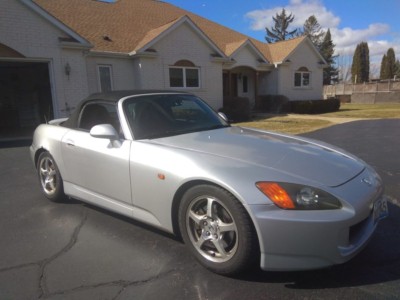 This is, by leaps and bounds, my favorite car I’ve driven stock. With the high-strung F20C (or F22C1 for the AP2 models), a lightweight chassis, the perfect manual transmission, and overall gorgeous styling cues, this was an instant classic. Picking up chicks/dudes in this car was a breeze, so was just taking a relaxing afternoon drive. I could take it to Walmart one day, and the drift track the next, and never have an issue with it. Even with mine, despite having gone through 3 engines and 2 transmissions, that car was incredibly reliable. To and from school every day, cold starts at 15 degrees, I even used it for a school project once in Calculus.
This is, by leaps and bounds, my favorite car I’ve driven stock. With the high-strung F20C (or F22C1 for the AP2 models), a lightweight chassis, the perfect manual transmission, and overall gorgeous styling cues, this was an instant classic. Picking up chicks/dudes in this car was a breeze, so was just taking a relaxing afternoon drive. I could take it to Walmart one day, and the drift track the next, and never have an issue with it. Even with mine, despite having gone through 3 engines and 2 transmissions, that car was incredibly reliable. To and from school every day, cold starts at 15 degrees, I even used it for a school project once in Calculus.
This car even has features to stop you from blowing it up on accident. Namely, the multi-step rev limiter. When the car is cold or low on oil, it won’t engage VTEC, and the redline becomes 6k RPM. I’ll be real, I will never bad-mouth the S2000. I’ve had nothing but good experiences with it, and I know that engine would’ve grown with me and my talents. Forced Induction is common on these, and you can pump 400 on stock internals. Replace the internals and bore the cylinders, go with a big single turbo setup, it’s not unheard of to hit 800-1k horsepower. When people say “Miata is always the answer!”, that’s usually because they didn’t have the money for an S2000!
Cons
I think this is the only car that doesn’t actually have any cons! It’s fun, fast, reliable, safe, and a convertible too. It came in manual, and best of all, values are rising. If you can find one for under $10k, snatch it up immediately, and give it a little TLC, you’ll double your money almost!
11) Mazda RX-7 ($18,000-$40k+)
 We’re talking about the FD generation here, none of the others. From 1993-2002, roughly. This is easily the hardest car to get your hands on out of the whole list. Even if you had the money, finding one is incredibly difficult. However, if you can get your hands on one, the appreciation these cars are experiencing is nuts. While they may not have retailed for much when they first came out, between the popularity they got from Fast and Furious, and their quirky rotary engines, they’ve become even more scarce and valuable. While reliability is thrown out the window, the fun you’ll have when it is running is immeasurable. Nothing sounds quite like a screaming rotary engine, and definitely nothing feels like one.
We’re talking about the FD generation here, none of the others. From 1993-2002, roughly. This is easily the hardest car to get your hands on out of the whole list. Even if you had the money, finding one is incredibly difficult. However, if you can get your hands on one, the appreciation these cars are experiencing is nuts. While they may not have retailed for much when they first came out, between the popularity they got from Fast and Furious, and their quirky rotary engines, they’ve become even more scarce and valuable. While reliability is thrown out the window, the fun you’ll have when it is running is immeasurable. Nothing sounds quite like a screaming rotary engine, and definitely nothing feels like one.
The styling on these cars in unique and incredible, as well. Despite having such a small and compact engine, the hood curves gently towards the front, where the greatest thing known to man lie: pop-up headlights. This truly is the car for any hardcore enthusiast, as long as you have the money to drop on it.
Cons
Reliability, and the cost of entry. Reliability is extremely low, between the faulty design of Apex Seals and the battle to not let the engine overheat. You’ll constantly be sinking money into this car just to keep it running. That’s added on to the initial cost, where you’re forking over nearly $20,000 to even smell one of these cars. Overall, not the most practical drift choice, but you’ll garner respect anywhere you go.
Which One Is Best?
That is an extremely opinion-based question. Depending on your budget, taste in cars, and time availability, your answer would change. For me? Hands down, the S2000. With an almost perfect reliability record for me, a comfortable interior, and a surprising amount of room in the trunk (enough to fit an adult male, don’t ask how I know), it makes a reliable daily. That, and the high-strung engine, smooth gearbox, and light chassis, it makes for a great drift machine.
Regardless of which car you choose, there’s going to be a few things to do before you’re ready to drift! If you’re looking to get into drifting for cheap, check out our other articles on Cheap, yet Crucial Interior Modifications for Drifting, and Drivetrain Modifications That Keep You Sideways (without breaking your car, or the bank!).

